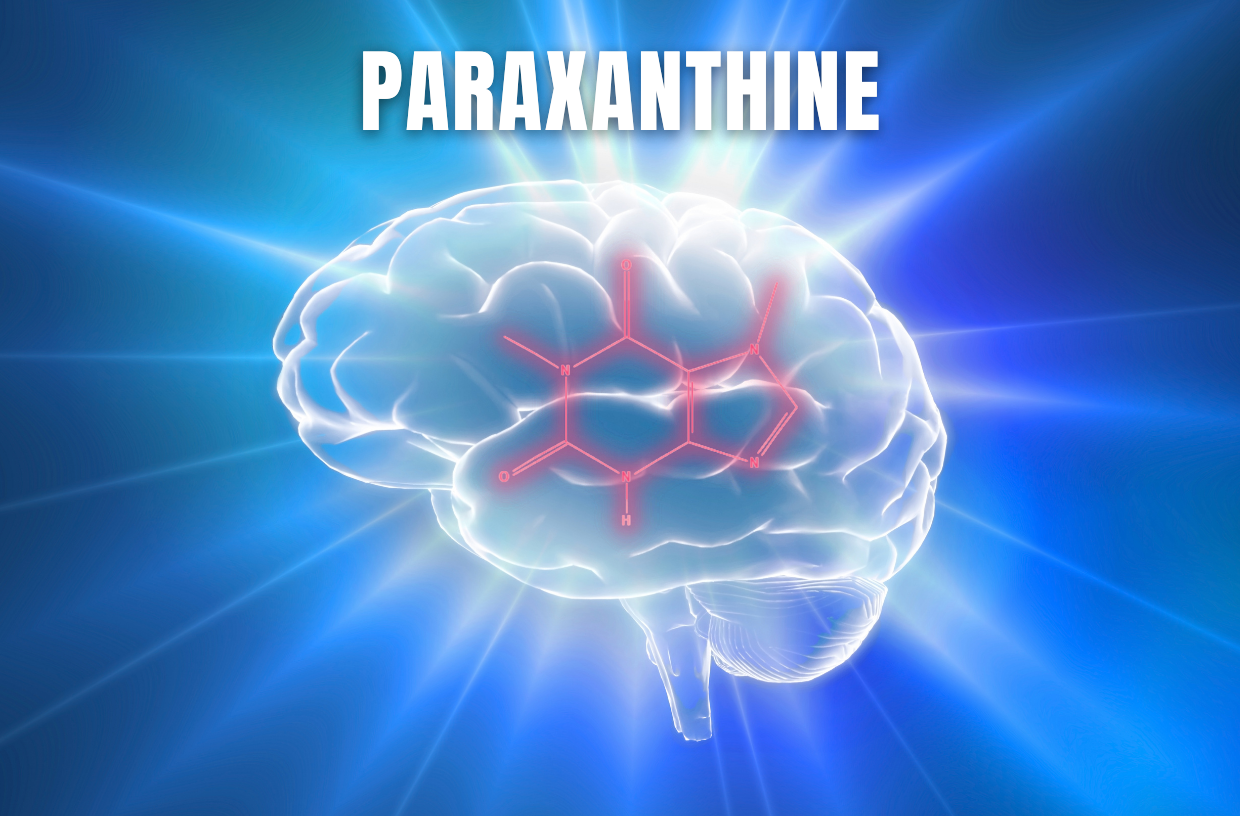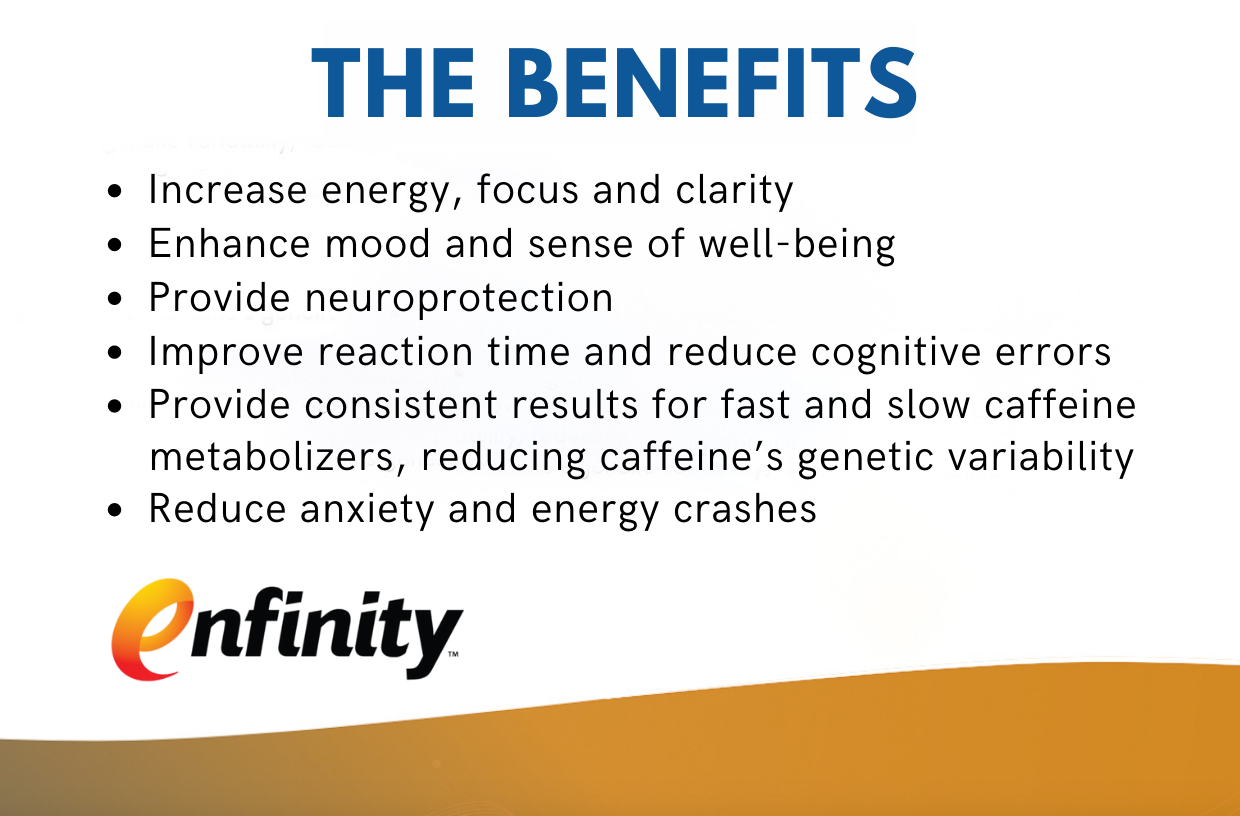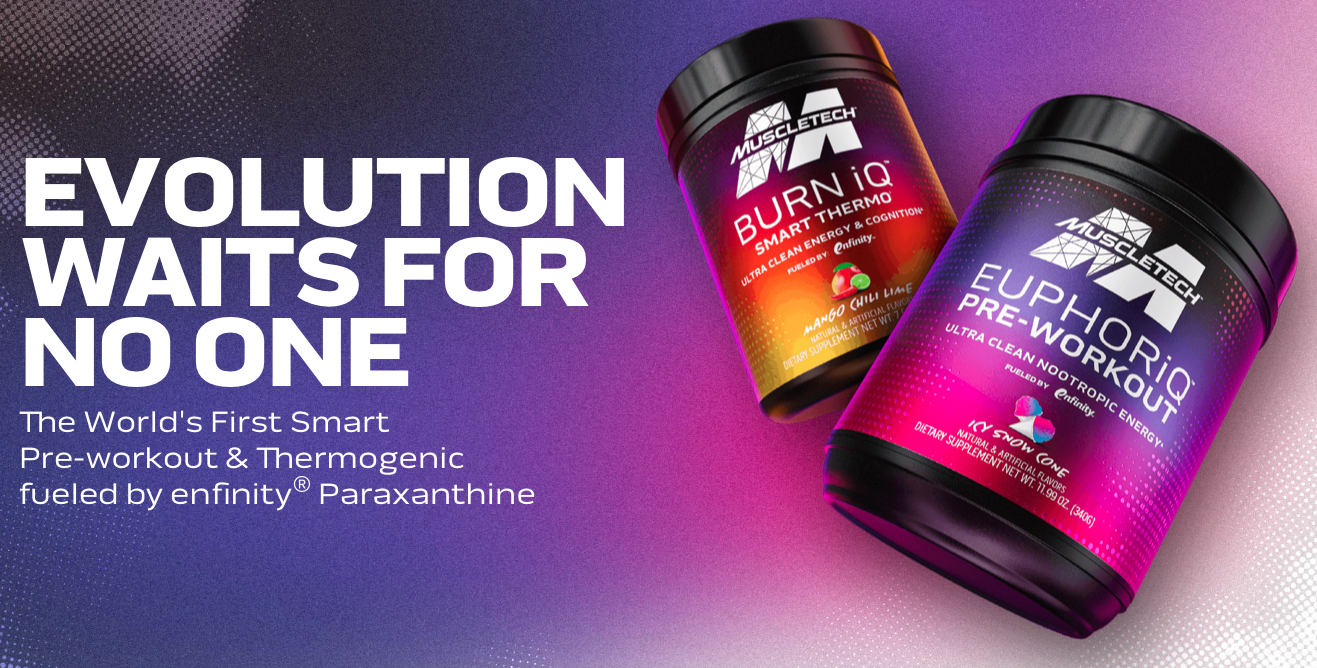What Is Paraxanthine

Caffeine is the most widely used central nervous system stimulant in the world. It’s used to overcome fatigue, improve cognitive function, and increase energy and even athletic performance, including aerobic and anaerobic performance, muscle strength, power and endurance. It can also increase metabolic rate and reduce pain perception, which is key to maximizing human performance.
Biochemically, caffeine is a methylxanthine that can be found naturally in seeds, fruits, nuts and leaves in several tropical plants, but its best-known source is, of course, from coffee beans. It’s widely used in pre-workout powders, nootropics, weight-loss formulas and energy drinks. Despite all of caffeine’s benefits, there’s wide variance in its positive effects.
The efficacy of caffeine supplementation may be affected by dose, format, time of ingestion, training status and even an individual’s genetic ability to metabolize caffeine! In fact, less than half of those who consume caffeine metabolize it well and get the full positive benefits. For slow metabolizers of caffeine, consumption may result in little to no energy from it and may even cause anxiety, sleeplessness, gastrointestinal distress, headaches and increased heart rate. We all know people who can drink a cup of tea or coffee and go to bed shortly afterwards whereas others are completely wired. Science is starting to prove there’s a huge difference in how different people metabolize caffeine, and it all centers around your ability or inability to convert caffeine into paraxanthine, which is the primary active ingredient responsible for caffeine’s positive benefits. This might explain why some people get great results from a pre-workout or fat burners while others don’t.
3 Caffeine Metabolites
Scientists have looked at the metabolites of caffeine as potential caffeine replacements instead of the caffeine itself. The three major metabolites are theobromine, theophylline and paraxanthine, which have completely different effects in your body.  Paraxanthine is the most desirable of the three metabolites. It behaves like caffeine as an adenosine antagonist but with greater potency, less toxicity and fewer side effects than caffeine itself. Researchers at a company called Ingenious Ingredients have teamed up with NNB Nutrition to manufacture a patent-pending form of paraxanthine called ENFINITY paraxanthine.
Paraxanthine is the most desirable of the three metabolites. It behaves like caffeine as an adenosine antagonist but with greater potency, less toxicity and fewer side effects than caffeine itself. Researchers at a company called Ingenious Ingredients have teamed up with NNB Nutrition to manufacture a patent-pending form of paraxanthine called ENFINITY paraxanthine.
Ingenious Ingredients & NNB Nutrition Partnership
 Ingenious Ingredients has formed a partnership with NNB Nutrition in the manufacturing of ENFINITY paraxanthine. Muscle Insider fans who've been reading our content and watching our YouTube channel know that NNB Nutrition has brought some of the most innovative ingredients to the dietary supplement market, including MitoBurn L-BAIBA, C8Vantage MCTs, MitoPrime L-ergothioneine, Puremidine spermidine and many more.
Ingenious Ingredients has formed a partnership with NNB Nutrition in the manufacturing of ENFINITY paraxanthine. Muscle Insider fans who've been reading our content and watching our YouTube channel know that NNB Nutrition has brought some of the most innovative ingredients to the dietary supplement market, including MitoBurn L-BAIBA, C8Vantage MCTs, MitoPrime L-ergothioneine, Puremidine spermidine and many more.
 This review will go over the mechanism of paraxanthine, the benefits and differences compared to caffeine and what to expect with supplementation.
This review will go over the mechanism of paraxanthine, the benefits and differences compared to caffeine and what to expect with supplementation.
Paraxanthine: Caffeine’s Main Metabolite
 Paraxanthine is a natural phytocompound that can be found in coffee, cacao fruit, Sinomenium acutum and the stamens of citrus flowers. It’s also the main metabolite of caffeine. In the body, caffeine is metabolized in the liver by demethylation to dimethylxanthines via the cytochrome P450 enzyme system, specifically the CYP1A2 isozyme.1
Paraxanthine is a natural phytocompound that can be found in coffee, cacao fruit, Sinomenium acutum and the stamens of citrus flowers. It’s also the main metabolite of caffeine. In the body, caffeine is metabolized in the liver by demethylation to dimethylxanthines via the cytochrome P450 enzyme system, specifically the CYP1A2 isozyme.1
Chemically, paraxanthine is 1,7-dimethylxanthine with two methyl groups located at positions 1 and 7. Paraxanthine accounts for about 80 percent of caffeine ingested, with smaller percentages of caffeine being metabolized to theobromine and theophylline.1 It’s been shown that 11 percent of caffeine ends up as theobromine and 4 percent as theophylline.1
Pharmacokinetics of Paraxanthine
 Compared with theobromine, theophylline and caffeine, paraxanthine has the shortest half-life and greatest plasma clearance. Paraxanthine has a half-life of 3.1 hours, compared to caffeine at 4.1 hours, and significantly different from theophylline at 6.2 hours and theobromine at 7.2 hours.2,3
Compared with theobromine, theophylline and caffeine, paraxanthine has the shortest half-life and greatest plasma clearance. Paraxanthine has a half-life of 3.1 hours, compared to caffeine at 4.1 hours, and significantly different from theophylline at 6.2 hours and theobromine at 7.2 hours.2,3
The total plasma clearance of paraxanthine (2.20 mL/min/kg) is greater than caffeine (2.07 mL/min/kg) and significantly greater than theobromine (1.20 mL/min/kg) and theophylline (0.93 mL/min/kg).3
In addition, paraxanthine has lower toxicity than caffeine and is the least harmful of the caffeine-derived metabolites.4 Paraxanthine is also less anxiogenic (anxiety inducing) than caffeine.4 Paraxanthine is unlike other caffeine metabolites that can induce nausea, diarrhea, tachycardia and arrhythmia.
ENFINITY paraxanthine has been tested in several toxicological studies to assess mutagenicity, genotoxicity, and acute and repeated dose oral toxicity in rats, where no observed toxic effects were reported.5
Safety Profile of Paraxanthine
 A toxicology study determined the LD 50 (the amount of substance administered that causes death in 50 percent of test animals) for paraxanthine to be 1601 mg/kg of body weight.5 The LD 50 of caffeine is much lower, at 192 mg/kg, suggesting that caffeine has significantly greater levels of toxicity than paraxanthine alone.6
A toxicology study determined the LD 50 (the amount of substance administered that causes death in 50 percent of test animals) for paraxanthine to be 1601 mg/kg of body weight.5 The LD 50 of caffeine is much lower, at 192 mg/kg, suggesting that caffeine has significantly greater levels of toxicity than paraxanthine alone.6
Additionally, the LD 50 for caffeine’s metabolites theobromine and theophylline are 1,265 mg/kg and 225 mg/kg.7,8 These findings indicate that caffeine is more toxic likely due to its metabolites other than paraxanthine, further supporting paraxanthine to be a means to achieve the CNS-stimulating effects of caffeine without the side effects that are likely attributable to caffeine’s other metabolites.
Fast & Slow Metabolizers of Caffeine – Genetic Variance of CYP1A2
 The metabolism of caffeine may influence the amount of paraxanthine available. The plasma ratio of paraxanthine to caffeine can determine if someone is a “fast” or “slow” metabolizer, which in turn will determine if there’s a high or low level of paraxanthine.
The metabolism of caffeine may influence the amount of paraxanthine available. The plasma ratio of paraxanthine to caffeine can determine if someone is a “fast” or “slow” metabolizer, which in turn will determine if there’s a high or low level of paraxanthine.
Evidence suggests genetic polymorphisms influence an individual’s response and metabolism of caffeine.9 Caffeine is a potent adenosine receptor antagonist: Caffeine blocks the actions of adenosine in the central nervous system. A single nucleotide polymorphism (SNP) of the gene that encodes for the adenosine A2A receptor has been used to categorize individuals as having a high or low sensitivity to caffeine.10
The P450 enzyme is responsible for 95 percent of the body’s caffeine metabolism, converting caffeine to paraxanthine. Hence, polymorphism in the gene that encodes for the CYP1A2 isoform may also be responsible for individual differences.10 The SNP can affect CYP1A2 enzyme activity and has been used to identify individuals as “fast” or “slow” caffeine metabolizers. Those with a homogenous A allele of the CYP1A2 gene tend to produce more cytochrome P450 and consequently metabolize caffeine more quickly.10
In a randomized, controlled trial to examine CYP1A2 genotype and exercise performance, it was found that caffeine enhanced 10 km time trial cycling performance among only “fast” caffeine metabolizers.11 In another study, “fast” metabolizers demonstrated a greater improvement in 40 km time trial cycle ergometer performance following caffeine ingestion than “slow” metabolizers.12
Thus, “fast” metabolizers may consistently experience greater benefits associated with caffeine. Because less than 50 percent of the population are “fast” metabolizers, using ENFINITY paraxanthine may eliminate this genetic variance, allowing for more optimal performance results.
Paraxanthine’s Mechanism of Action
 Paraxanthine, like caffeine, is also a central nervous system stimulant that induces locomotor activation by its ability to block adenosine receptors. However, paraxanthine appears to have higher binding potencies for adenosine A1 and A2a receptors.13 In fact, paraxanthine has a stronger locomotor activating effect than caffeine, theobromine and theophylline.14 The differences in the locomotor activating effects of paraxanthine and caffeine are related to differences in their ability to inhibit cGMP (cyclic guanosine monophosphate) preferring phosphodiesterases (PDEs).14
Paraxanthine, like caffeine, is also a central nervous system stimulant that induces locomotor activation by its ability to block adenosine receptors. However, paraxanthine appears to have higher binding potencies for adenosine A1 and A2a receptors.13 In fact, paraxanthine has a stronger locomotor activating effect than caffeine, theobromine and theophylline.14 The differences in the locomotor activating effects of paraxanthine and caffeine are related to differences in their ability to inhibit cGMP (cyclic guanosine monophosphate) preferring phosphodiesterases (PDEs).14
It has been demonstrated that paraxanthine, but not caffeine, induces a significant increase in the striatal concentration of cGMP.14 Results strongly suggest the existence of an interaction of two main mechanisms—A1 receptor antagonism and PDE inhibition—as being responsible for the locomotor activating effects of paraxanthine, increasing release of the neurotransmitters glutamate and dopamine by potentiating nitric oxide signaling.14
In addition, paraxanthine potentiates neurotransmission by potentiating nitric oxide (NO) neurotransmitter signaling. PDE9 terminates NO neurotransmission by metabolizing cGMP back to GMP. Paraxanthine inhibits PDE9, allowing potentiation of NO transmission and encouraging dopamine release. Caffeine doesn’t have this effect.
Paraxanthine’s competitive PDE inhibition can also increases intracellular cAMP/PKA (cAMP-dependent protein kinase) pathways and inhibits TNF-α and leukotriene synthesis.15
Caffeine vs. Paraxanthine: CNS Effects
 Paraxanthine has been shown to have much of the same effects on the central nervous system as caffeine. In one study, subjects were given caffeine or paraxanthine at 2 or 4 mg/kg or placebo, each after three days of abstinence from methylxanthine.16 Both caffeine and paraxanthine significantly increased diastolic blood pressure, plasma epinephrine levels and free fatty acids, which are indications of their ergogenic and fat-burning abilities.
Paraxanthine has been shown to have much of the same effects on the central nervous system as caffeine. In one study, subjects were given caffeine or paraxanthine at 2 or 4 mg/kg or placebo, each after three days of abstinence from methylxanthine.16 Both caffeine and paraxanthine significantly increased diastolic blood pressure, plasma epinephrine levels and free fatty acids, which are indications of their ergogenic and fat-burning abilities.
Caffeine and paraxanthine produced a similar magnitude of response at 4 mg/kg; however, caffeine appeared to produce greater responses than paraxanthine, at 2 mg/kg.16 Caffeine and paraxanthine, therefore, have similar sympathomimetic actions.
Paraxanthine Improves Cognition, Short Term Memory & Sustained Attention
 Paraxanthine has been tested in clinical trials for its ability to improve cognitive flexibility, sustain attention and improve working memory and inhibitory control.
Paraxanthine has been tested in clinical trials for its ability to improve cognitive flexibility, sustain attention and improve working memory and inhibitory control.
In one of the clinical trials, acute paraxanthine ingestion was observed to improve cognition and short-term memory and help sustain attention. The trial used a randomized, double-blind, placebo-controlled, crossover and counterbalanced method, including 12 healthy male and female subjects (24±5 years, 170.0±12 cm, 72.9±19 kg, 24.8±4 kg/m2) that were randomly assigned to consume a placebo (PL) or 200 milligrams of ENFINITY™ paraxanthine.17
Participants completed stimulant sensitivity and side effect questionnaires and then performed a series of standard cognitive function tests including the Berg-Card Sorting task test (BCST), which is an executive function test that assesses long thought, including reasoning, learning, executive control and attention shifting; the Go/No-Go test (GNG), which assesses sustained attention and response control through reaction time and accuracy to visual stimuli; the Sternberg task test (STT), which assesses short-term/working memory involving cognitive control processes using reaction time and accuracy; and the Psychomotor Vigilance Task Test (PVTT), which assesses sustained attention reaction times through responses to visual stimuli.
Participants then ingested either a placebo or paraxanthine with 8 ounces of water and then completed the same set of side effect questionnaires and cognitive function tests after each hour for six hours. After seven days, participants then repeated the experiment while consuming the alternative treatments.
The results from this study indicate that paraxanthine supplementation led to faster response times, less mental fatigue and a higher percentage of correct answers and a reduction in errors, while the placebo group showed a significant decrease in correct answers.17 Paraxanthine supplementation also increased the capacity for sustained attention (that is, maintaining reaction times and preventing mental fatigue), while the placebo group showed significantly reduced reaction times. Paraxanthine was also found to increase cognitive flexibility and decrease mean response times by 3.9 percent faster compared with the placebo, at 2.7 percent.17 Lastly, paraxanthine significantly increased short-term working memory.17
Improves Cognitive Function & Psychomotor Vigilance
 In another double-blind, placebo-controlled, crossover and counterbalanced trial, 13 trained runners (27.1±5 years, 68.6±9 kg, 22.2±2.7 kg/m2, 15.7±5 percent fat, 53.7±11 mL/kg/min VO2 peak) were randomly assigned to consume 400 mg of placebo (PL), 200 mg of PL + 200 mg of caffeine (CA), 200 mg of PL+ 200 mg of ENFINITY™ paraxanthine (PX) or 200 mg CA + 200 mg of PX (CA+PX) with a seven-day washout between treatments.18
In another double-blind, placebo-controlled, crossover and counterbalanced trial, 13 trained runners (27.1±5 years, 68.6±9 kg, 22.2±2.7 kg/m2, 15.7±5 percent fat, 53.7±11 mL/kg/min VO2 peak) were randomly assigned to consume 400 mg of placebo (PL), 200 mg of PL + 200 mg of caffeine (CA), 200 mg of PL+ 200 mg of ENFINITY™ paraxanthine (PX) or 200 mg CA + 200 mg of PX (CA+PX) with a seven-day washout between treatments.18
Fasting blood samples from each participant were obtained, and each completed pre-supplementation side effects questionnaires along with the BCST and the PVTT. Participants then rested for 60 minutes, repeated tests, performed a 10 km run on a treadmill (48.4±6.7 min) and then performed a post exercise set of tests.
Data analyzed from the BCST results revealed that paraxanthine increased correct responses and reduced errors, while caffeine increased errors. After exercise, all groups but the paraxanthine group increased total errors, indicating fatigue. Paraxanthine significantly improved errors, showing a 10.6 percent decrease, compared to caffeine, which showed a 23.3 percent increase.18 The paraxanthine group also had faster post-exercise response times than the placebo group.18
Additionally, paraxanthine also showed faster response times, in both pre-exercise tests (compared to placebo) and post-exercise tests (compared to caffeine).18 The results of this clinical trial indicate that acute paraxanthine supplementation, independent of caffeine, improves cognition before and after exercise and reduces fatigue. This trial also indicates that adding caffeine to paraxanthine doesn’t provide any additional benefits.18
Increases Muscle Mass, Strength & Endurance
 Paraxanthine supplementation was evaluated for its effects after 28 days on muscle mass, strength and endurance performance in comparison to other common ingredients commonly used in sport supplements, including L-theanine, alpha-GPC and taurine.19
Paraxanthine supplementation was evaluated for its effects after 28 days on muscle mass, strength and endurance performance in comparison to other common ingredients commonly used in sport supplements, including L-theanine, alpha-GPC and taurine.19
Male Swiss albino mice in five groups were orally given paraxanthine (20.5 mg/kg/day, human equivalence dose [HED] 100 mg), L-theanine (10.28 mg/kg/day, HED 50 mg), alpha-GPC (41.09 mg/kg/day, HED 200 mg), taurine (102.75 mg/kg/day, HED 500 mg), or control (carboxy methyl cellulose) for four weeks.
Exercise performance was evaluated using forelimb grip strength and treadmill endurance exercise. All animals were subject to treadmill training for 60 minutes, 5 days per week. Blood draws were utilized to analyze lipid profile, liver health, renal function and nitric oxide levels.
Paraxanthine significantly increased forelimb grip strength by 17 percent, treadmill exercise performance by 39 percent, gastrocnemius and soleus muscle mass by 14 percent and 41 percent, respectively, and nitric oxide levels by 100 percent compared to control, while reducing triglyceride, total cholesterol and LDL, and increasing HDL compared to control and compared to L-theanine, alpha-GPC and taurine.19
Results from this initial study indicate that, when compared to the control, L-theanine, alpha-GPC and taurine, paraxanthine is an effective ingredient for improving sport performance.
Formulating with ENFINITY’s Paraxanthine
 ENFINITY™ paraxanthine has been shown to be a more effective and safer—less toxic and with fewer side effects—ingredient than caffeine. Paraxanthine at the same dose is also less bitter than not only caffeine but also other methylxanthines. In addition, paraxanthine requires the same dosing as caffeine (between 100 and 300 milligrams per serving) for an easy replacement for existing energizing, pre-workout or cognitive function formulations.
ENFINITY™ paraxanthine has been shown to be a more effective and safer—less toxic and with fewer side effects—ingredient than caffeine. Paraxanthine at the same dose is also less bitter than not only caffeine but also other methylxanthines. In addition, paraxanthine requires the same dosing as caffeine (between 100 and 300 milligrams per serving) for an easy replacement for existing energizing, pre-workout or cognitive function formulations.
To summarize, formulating with ENFINITY’s Paraxanthine can:
 ENFINITY paraxanthine is HPLC purity tested and patent-pending, with GRAS documentation filed. ENFINITY paraxanthine is already being formulated into pre-workout, fat-burning and nootropic supplements, including MuscleTech’s Burn iQ and EuphoriQ, as well as the zero-sugar smart energy drink called Update.
ENFINITY paraxanthine is HPLC purity tested and patent-pending, with GRAS documentation filed. ENFINITY paraxanthine is already being formulated into pre-workout, fat-burning and nootropic supplements, including MuscleTech’s Burn iQ and EuphoriQ, as well as the zero-sugar smart energy drink called Update.

About NNB Nutrition
NNB Nutrition is an innovative technological enterprise dedicated to research, development, production and sales of innovative nutrient raw materials. In cooperation with world-class scientists such as Shawn Wells, NNB has built one of the top international research and development teams in the industry, using customized processing methods to create and produce new raw materials such as paraxanthine. NNB insists on taking technological innovation as its core productivity, fully guaranteeing product quality and devoting itself to creating innovative ingredients for human performance and health.
 For more info or to include this ingredient in your next formula, visit nnbnutrition.com.
For more info or to include this ingredient in your next formula, visit nnbnutrition.com.
References:
- Lajin B, et al. The determination of the paraxanthine/caffeine ratio as a metabolic biomarker for CYP1A2 activity in various human matrices by UHPLC-ESIMS/MS. Talanta. 2021. 234.
- Institute of Medicine (US) Committee on Military Nutrition Research. Caffeine for the Sustainment of Mental Task Performance: Formulations for Military Operations. Vol 2. National Academies Press (US); 2001. Accessed May 23, 2019.
- Lelo A, et al. Quantitative assessment of caffeine partial clearances in man. Br J Clin Pharmacol. 1986. 22(2): 183-6.
- Stavric B. Methylxanthines: toxicity to humans. 3. Theobromine, paraxanthine and the combined effects of methylxanthines. Food Chem Toxicol. 1988. 26(8):725-733.
- Purpura M, et al. An assessment of mutagenicity, genotoxicity, acute-, subacute and subchronic oral toxicity of paraxanthine (1,7-dimethylxanthine). Food Chem Toxicol. 2021. 158. 112579.
- Fisher Scientific. Caffeine Safety Data Sheet. Published online January 17, 2018.
- Theobromine - 3,7-Dimethylxanthine. Accessed June 14, 2021.
- Theophylline - 1,3-Dimethylxanthine. Accessed June 14, 2021.
- Cornelis MC, et al. Coffee, CYP1A2 genotype, and risk of myocardial infarction. JAMA. 2006. 295(10): 1135-41.
- Nehlig A. Interindividual Differences in Caffeine Metabolism and Factors Driving Caffeine Consumption. Pharmacol Rev. 2018. 70(2): 384-411.
- Guest N, et al. Caffeine, CYP1A2 genotype, and endurance performance in athletes. Med Sci Sports Exerc. 2018. 50:1570–1578.
- Womack CJ, et al. The influence of a CYP1A2 polymorphism on the ergogenic effects of caffeine. J Int Soc Sports Nutr. 2012. 9:7.
- Chou CC, Vickroy TW. Antagonism of adenosine receptors by caffeine and caffeine metabolites in equine forebrain tissues. Am J Vet Res. 2003. 64:216–224.
- Orrú M, et al. Psychostimulant pharmacological profile of paraxanthine, the main metabolite of caffeine in humans. Neuropharmacology. 2013. 67:476–484.
- Horrigan LA, et al. Caffeine suppresses TNF-alpha production via activation of the cyclic AMP/protein kinase pathway. Int Immunopharmacology. 2004. 4(10-11): 1409-17.
- Benowitz NL, et al. Sympathomimetic effects of paraxanthine and caffeine in humans. Clin Pharmacol Ther. 1995. 58(6): 684-91.
- Yoo C, et al. Acute paraxanthine ingestion improves Acute Paraxanthine Ingestion Improves Cognition and Short-Term Memory and Helps Sustain Attention in a Double-Blind, Placebo-Controlled, Crossover Trial. Nutrients. 2021. 13(11): 3980.
- Xing D, et al. Paraxanthine provides greater improvement in cognitive function and psychomotor vigilance prior to and following running than caffeine. Poster Presented ISSN Conference, June 2021.
- Jager R, et al. Paraxanthine Supplementation Increases Muscle Mass, Strength, and Endurance in Mice. Nutrients. 2022. 14(4): 893.
*© Copyright Notice: Muscle Insider can’t always determine which images are protected by copyrights. We use images that are part of the public record and believed to be under the public domain. If for some reason somebody believes copyrights are violated we will remove or replace the content in question after receiving a DMCA notice.

